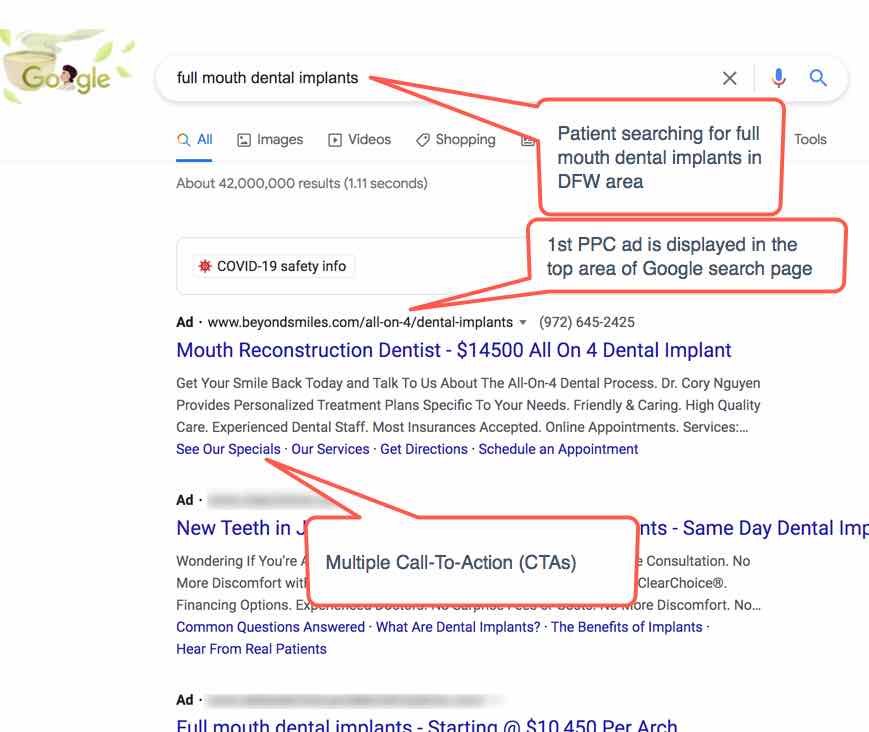How Much Healthcare Practices Spend On Advertising Per Month?
The actual advertising budget for each medical and dental practice is different. Some medical and dental practices are very aggressive and spend $1000 per day (or more) and some spend $1000 a month on advertising. Your advertising budget depends on your location, your services, your target area and your competition. U.S. health care industry spends $30 billion a year on marketing. If the owner and decision maker of a dental or medical practice is a physician, then they have a very difficult time understanding that advertising is NOT AN EXPENSE, it is an investment with an ROI. On the other hand, generally, if the practice owner, investor, decision maker is a business person, they typically understand the value of advertising for doctors. Some physicians spend nothing on advertising and depend strictly on word of mouth and SEO of the website.
Average Advertising Spend Annually Summary
Doctors & Medical Practices (one location)
- Small Practices: $4,000 – $12,000 annually (approx $650/month)
- Medium Practices: $12,000 – $48,000 annually (approx $2500/month)
- Large Practices: $50,000 – $150,000+ annually (approx $8333/month)
Dentists (one location)
- Small Practices: $5,000 – $15,000 annually
- Medium Practices: $15,000 – $50,000 annually
- Large Practices: $50,000 – $150,000+ annually
Insights from PatientGain:
Telemedicine providers typically need a larger budget – Please see details below
New practices spend more than established practices.
Practices with excellent SEO may only need to spend a small amount to no amount per month.
** Data from 2020 to 2025 – Updated every year. Also note that brands spend much more than non-brand focused medical practices, they also have more patients and perceived medical care provided is of higher value to patients, as evidenced by reviews received by the medical practices. The data is here for your guidelines and not guaranteed to generate same or similar results.
Table of Contents
1) Range is $800 per month to $15000 per month, depending on specialty and competition.
2) Medspa and aesthetic practices
3) Anti-aging, wellness, hormone, IV therapy practices
4) Plastic surgeons
5) Dermatology practices
6) Urgent care centers
7) Walk-in primary care practices
8) Primary care practices
9) Naturopathic, wellness focused care practices
10) Pediatric care practices
11) Sexual healthcare practices – multi-focus
12) Sexual healthcare practices – Erectile Dysfunction
13) Fertility healthcare practices
14) Dental practices – General dentists
15) Dental practices – General dentists with cosmetic focus (implants, Invisalign)
16) Dental practices – Specialist dentists
17) Dental practices – Celebrity & cosmetic focus
18) Podiatrists – Foot and Ankle Doctors and Surgeons
19) Orthopedic Surgeons
20) Women’s Health and OB/GYN
21) Weight loss / Physician Supervised Medical Weight Loss / Semaglutide and related weightloss
22) Integrative practices – Serving multiple focus areas
23) Regenerative/Integrative practices – Serving multiple focus areas
24) Chiropractor practices
25) Mental health & psychologists
26) Addiction & substance abuse medicine
27) Sleep clinics and TMJ clinics
28) Pain clinics – Chiropractors
29) Pain clinics – Spine focused – minimally invasive pain management and regenerative medicine
30) Physical therapy care practices
31) Telemedicine practices
32) Example of a Facebook Ad with an “Offer”
33) Example of an Instagram Ad with a “Contact Us” Call To Action
34) Example of an Google Pay-Per-Click Ad With Multiple Call To Actions
35) Example of a PatientGain Marketing Image Used To Attract Patients
The actual advertising budget for each clinic and practice is different. Some clinics/doctors are very aggressive and spend $1000 per day (or more) and some spend $1000 a month on advertising. We also have few clinics/doctors who do not spend any money on online advertising, these doctors rely on referrals and very strong SEO rankings. This data refers to online advertising, not offline advertising spend. For example we have a medical practice with 30+ locations, on average they spend – per location – $1600 per month on online mediums and $1000 per month for offline, traditional mediums. Another medical practice with 5 locations, spends $5400 per month per location, entirely on online strategy. They are no longer spending any advertising budget on offline, traditional advertising channels. A single location in 8 exam rooms, with extreme competition, spends $15000 per month on online advertising, with average patient count of 80 -110 patients per day. A plastic surgeon with medium competition spends $8000 per month on online advertising. One of our pain clinic does not spend anything on advertising, all of their leads come from SEO of their medical practice website, and referrals.
Also you have to understand that every practice area is different. If it’s a brand new practice, and they are just starting out, they will need to spend more $$ on the initial launch. If a practice is going through some issues (legal, business related, partnership, ownership change related etc) they may pause or stop all advertising. For example let’s review specific specialties:
For Medical Spas and Aesthetic practices, it is highly recommended to have online advertising budget. The typical range is $3000 to $11000 per month, with average budget of $4600 per practice in USA. If you are a new Medical Spa or aesthetic practice, you must allocate advertising budget for at least 1 to 2 years. Your advertising budget will depend on 1) where you are located 2) your competition 3) your services 4) your website 5) your staff
For anti-aging, wellness, hormone, IV therapy practices, it is highly recommended to have an advertising budget. The typical range is $2700 to $7200 per month, with average budget of $4100 per practice, per month in USA. Self care and self awareness and taking care of your own self has become a major area in US. We are constantly seeing more and more patients looking for these type of services. If these services are bundled with semaglutide and other related therapies, then it is even more effective marketing.
Plastic & aesthetics surgeons need online advertising, more than any other category. It is next to impossible to be successful without proper online advertising budget. The typical range is $5000 to $15000 per month, with average budget of $6900 per practice in USA.
The typical range is $2100 to $4400 per month, spend on average spend $2900 per month per location. However these are “average” locations with medium competition. If a dermatology is also focused on cosmetic procedures, their budgets are more like Medical Spas and aesthetic clinics. See above.
The typical range is $2200 to $9000 per month, spend on average spend $3950 per month per location. However these are “average” locations with medium competition. There are many factors, number of exam rooms and how many providers, and fixed overhead also dictates how aggressive each owner is. Brands and chains spend more on advertising as compared to stand alone locations. We have also noticed if the owner is a doctor/physician, vs a business person, doctor/physician owners will have a hard time understanding value of advertising. Doctor/physician owners view advertising and marketing as an expense, rather than an “investment” with an ROI (Return On Investment). If the owner of the practice is a business person, rather than a provider (doctor) they understand the concept of advertising and return on investment.
Walk-in Clinics – with primary care services and some “urgent care” services spend $1900 to $4300 per month, with an average monthly budget of $3000 per month. Walk-in practices are now competing with Urgent cares and primary care both.
Primary care doctors spend $1000 to $3200 per month, with an average monthly budget of $2300 per month. If primary care is offering additional services, like semaglutide for medical weight loss, then the budget will be much higher. We are also have data about “concierge” or “direct pay” providers who provide patient higher standard of care and attention, while doctors can keep their patient engaged and build long-term relationships with patients. Each patient gets more attention. These practices spend 2500 to $4300 per month.
Naturopathic, wellness providers spend $1900 to $3900 per month, with an average monthly budget of $2850 per month per location. If you are offering many services, then your budget will be higher.
Pediatric practices usually have a network of referral business, but they are increasingly advertising also. The typical range is $1400 to $2900 per month, spend on average spend $2100 per month per location.
Sexual health practices are typically men or women focused. These practices typical range is $3000 to $8500 per month, spend on average spend $4500 per month per location.
ED clinics are very competitive, with a typical range is $4000 to $10000 per month, spend on average spend $5700 per month per location.
Fertility, IVF, reproductive healthcare practices have very high average revenue per patient. But is is very competitive also. The typical range is $3300 to $7500 per month, spend on average spend $4700 per month per location.
The typical range is $1700 to 3700 per month, spend on average spend $2550 per month per location.
These dental practices treat general dentistry patients, like cleaning, and yearly preventive exams, however their focus is big ticket items. This typically includes dental implants, Invisalign, and other similar services. The typical range is $2600 to 6900 per month, spend on average spend $4500 per month per location.
The typical range is $1600 to 3500 per month, spend on average spend $2800 per month per location. These type of practices include Endodontists, TMJ disorders, sleep apnea, oral appliances etc.
The typical range is $8300 to $18850 per month, spend on average spend $9500 per month per location. These type of practices include dentists who do not accept insurance, and accept limited amount of patients, but each patient is treated as a “celebrity” with extreme focus on customer service, and results for each patient. Services include Invisalign, porcelain veneers, whitening, bonding, laminates, implants, and orthodontics.
The typical range is $1500 to 3300 per month, spend on average spend $1900 per month per location.
The typical range is $1800 to 4100 per month, spend on average spend $2600 per month per location. If your focus is on cash-pay services, then you will need to spend a lot more on advertising.
The typical range is $1400 to 4100 per month, spend on average spend $2700 per month per location.
With the advent of Semaglutide based medications for weight loss, there is a lot demand but so is the competition for patients. Typical range is $2000 to $6300 per month, spend on average spend $4050 per month per location.
The typical range is $1600 to 3500 per month, spend on average spend $2850 per month per location. These type of practices include multiple focused areas, like heart health, general wellness, diabetic patients, mind – brain wellness, pain management, hormonal imbalance and many other areas. These type of practices have to compete with traditional non-integrative practices, so conversion cost per patient is higher than traditional primary care practices.
The typical range is $1600 to 5000 per month, spend on average spend $3100 per month per location. These type of practices include multiple focused areas, like regenerative medicine, spinal decompression therapy, chiropractic care, neuropathy treatments, active physical rehabilitation, back braces/knee braces, PRP based treatments. These type of practices have to compete with traditional non-integrative practices, so conversion cost per patient is higher than traditional primary care practices. However, there are a lot of limitations from Google and Meta on what type of words and services can be used for advertising.
The typical range is $1700 to 3800 per month, spend on average spend $2900 per month per location. Traditional chiropractic medicine treatments covering problems that occur in musculoskeletal system, including muscles, ligaments, cartilage, bones, tendons, and nervous system. They employ soft tissue therapies, at home exercises & manipulating the spine or joints.
The typical range is $1700 to 3200 per month, spend on average spend $2400 per month per location. If you are a telemedicine only practice, then scroll down and read about telemedicine practices. Telemedicine only practices, with no physical address, will have a hard time getting SEO and local SEO so they have to depend a lot on digital advertising. And there are a lot of restrictions on mental health advertising on Facebook, Instagram and Google.
The typical range is $1200 to 3800 per month, spend on average spend $2600 per month per location.
The typical range is $1200 to 3600 per month, spend on average spend $2540 per month per location.
The typical range is $1800 to 3800 per month, spend on average spend $2650 per month per location.
The typical range is $1500 to 3500 per month, spend on average spend $2600 per month per location.
Physical therapy clinics have expanded into many areas and they offer services overlapping with other practices also. For example here is list of services for physical therapy practice : post-surgery rehabilitation, senior rehabilitation programs, work injury rehabilitation, back stabilization, balance training, functional capacity evaluations, neurological rehabilitation, orthopedic rehabilitation, pain management, physical therapy, wellness & weight loss program, vestibular sports medicine, graston technique, fitness program – So this can be quite large. Most clinics like these spend $1600 to $3700 per month, with an average monthly budget of $2600 per month, per location.
Cost for patient acquisition for telemedicine providers is much higher for smaller practices, compared to larger providers.
Use case 1: Small practice in rural area targeting approx. 200,000 population = $1500/mon. All of these ads should be digital ads. Local SEO does not work effectively for telemedicine practices.
Use case 2: Small-Medium size practice, targeting an area 3 areas of each approx. 200,000 population = $1500/mon times 3 = $4500/mon. All of these ads should be digital ads. Local SEO does not work effectively for telemedicine practices.
Use case 3: Medium size practice, targeting an area targeting approx. 2 million population = $12,000/mon. For example if you are targeting entire state of NM, that would be approximately 2 million population. All of these ads should be digital ads. Local SEO does not work effectively for telemedicine practices.
Data from 2020 to 2025 updated each year. Also note that brands spend much more than non-brand focused medical practices, they also have more patients and perceived medical care provided is of higher value to patients, as evidenced by reviews received by the medical practices. The data is here for your guidelines and not guaranteed to generate same or similar results.




